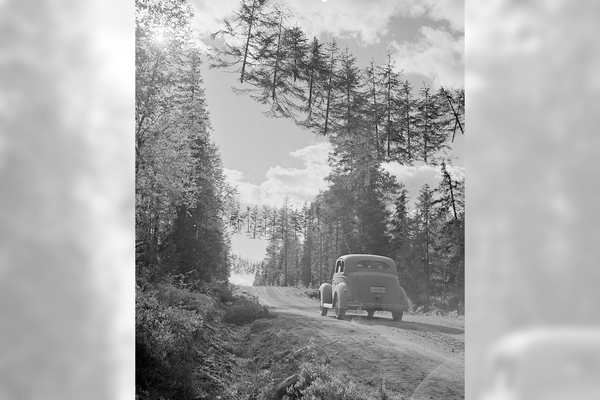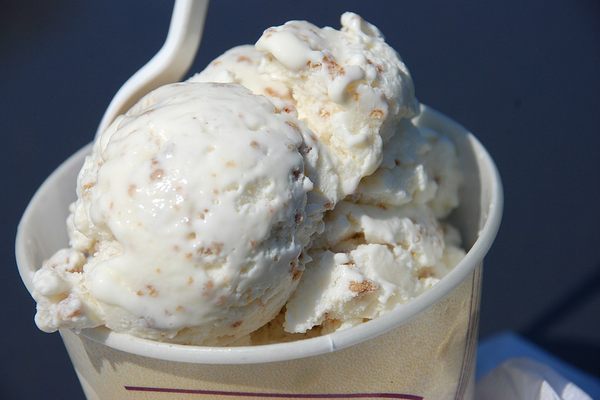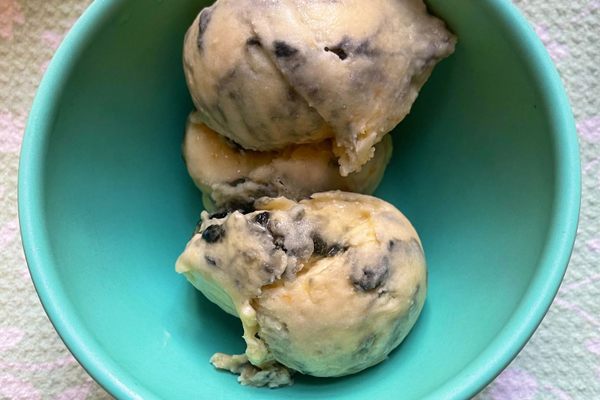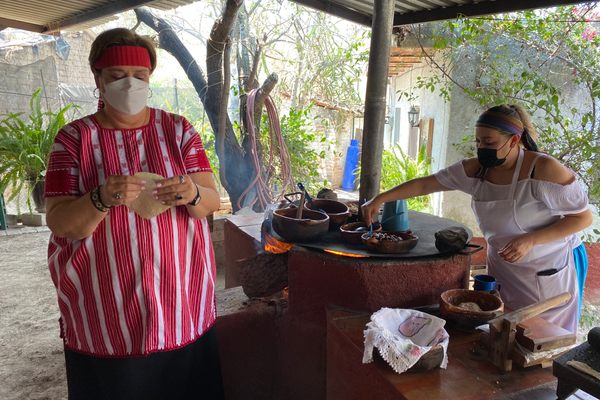Make the Jellied Delicacy Served Aboard the Titanic
For their last meal, first-class passengers dined on 11 courses, including Chartreuse jelly and peaches.
On April 14, 1912, the night before the RMS Titanic sank, the passengers in first class dined on a sumptuous 11-course feast. There was a parade of hors d’oeuvres, plus freshly shucked oysters. There was spring lamb with mint jelly, asparagus in vinaigrette, poached salmon with mousseline sauce, filet mignon, and roast duckling. The bartenders were pouring Rob Roys, Clover Clubs, and a Robert Burns cocktail served with a side of shortbread cookies. There was Champagne, of course, both poured into crystal coupes and eaten in the form of Punch Romaine, a boozy sorbet that served as a palate cleanser.
“There were a number of elements about the last dinner that were very unusual or extravagant,” says Veronica Hinke, author of The Last Night on the Titanic: Unsinkable Drinking, Dining & Style. “One of the menu items that I love to talk about is Peaches and Chartreuse Jelly. Chartreuse has a little bit of a minty flavor to it and it’s green, so it’s really pretty.”
Captain Edward Smith, meanwhile, was at a private party celebrating his imminent retirement, and missed the whole feast. And while those in first class had their Chartreuse jelly, their fellow passengers in third class ate gruel.
“It was basically a watered down, mealy porridge, together with cheese and crackers,” Hinke says. “Supper was mainly intended to tide them over.”

To be fair, the main meal of the day would have been served at noon. The third class spread would have consisted of heartier fare, including roast beef, cabin biscuits, and plum pudding. Breakfast, meanwhile, consisted of oatmeal, smoked herring, jacket potatoes, and Swedish bread with marmalade.
While it still pales in comparison to the opulence of the one-percenters, for working-class passengers, the dining options would have seemed generous by the standards of the time. “This was a huge step up from what they would have experienced traveling in third class before the Titanic,” Hinke says. “They would in some cases have had to bring their own food for the whole family. Plus, there were even windows in the dining room—and there was a dining room, whereas on previous ships, [third-class passengers] would eat right where the sleeping accommodations were.”
More than a century after the Unsinkable Ship met its unfortunate end, the Titanic remains lodged in our collective imagination. It’s not just James Cameron’s epic melodrama—although, as the fourth-highest grossing movie of all time, that certainly hasn’t hurt. The ship’s screen presence is such that it’s been the subject of more than a dozen films, ranging from a 1964 American musical to a 1943 Nazi propaganda film personally overseen by Goebbels portraying the ship as a metaphor for American folly to a 2020 documentary about the Chinese immigrant survivors of the disaster. To this day, there are highly active Titanic Facebook groups, a Titanic book club, and a Titanic Museum in Branson, Missouri.

“When I was in junior high, the English teacher would read A Night to Remember to each class every year,” Hinke says, with regard to when her own fascination with the ship started. It helped that a well-to-do British gentleman who had lived in her hometown of Merrill, Wisconsin, and sailed on the ship was practically a local legend. “[My teacher] would give examples like the size of the Titanic was from our school to the library three or four blocks away, and explained all about the opulence onboard.”
Decades later as a food journalist, Hinke’s obsession led her to track down what passengers ate for their unwitting last meal—both for its historical significance and as a microcosm of dining in the Edwardian period. She found plenty of menus, along with other records of the dishes at the time.
“People wrote letters home because they were so excited to be on the Titanic,” Hinke says. “They wanted to share with their friends and loved ones what they were eating and drinking. One man, his name was Adolphe Saalfeld, wrote home to his wife, Gertrude, that he had just washed down lunch with a nice Spaten lager.”
Poring through all these archival menus and correspondences led to a few unexpected discoveries. For instance, first-class diners enjoyed French vanilla ice cream, while those in second class had American vanilla ice cream—the primary difference being that the latter contains eggs.
“One thing that’s surprising is that for the last dinner in second class, they had somewhat of a traditional American Thanksgiving meal, with roast turkey with cranberry sauce,” Hinke says. “They did that to acknowledge the destination, New York City.”
There were far less delightful discoveries as well. The cooks who prepared that final extraordinary dinner worked for a separate company, which meant that they were given no place on the lifeboats. “Sixty kitchen employees aboard the Titanic drowned like rats in a trap when the liner went down because stewards blocked their way when they attempted to go to the decks,” declared an investigative report published on June 7, 2012. Only about a dozen survived through a combination of quick-thinking and luck.

What Hinke found most moving during her research, and what remains one of the great tragedies of the Titanic, was not the food, but what the ship represented for so many. “This was the ‘Ship of Dreams,’ and it was filled with hope. One of the biggest examples of that is the immigrants that were coming to America, and many of them had never been here before,” she says. She uncovered evidence of immigrants from 15 countries, mostly in second and third class.
“They were leaving everything behind, and starting a new life here,” Hinke says. “And I think even though we zero in on the incredible first-class meals and all the opulence, the American Beauty roses and the style of the time, I think one of the most prevailing stories is the immigrant story.”
As she has done for many years, for the anniversary of the final night of the ship’s doomed voyage, Hinke prepared several of the more memorable menu items. The salmon with mousseline sauce is a perennial favorite among modern-day diners, as is the Punch Romaine. But one the real scene-stealer here is that wiggling, glinting Chartreuse jelly with peaches. It’s a classic that Tasting History and others have incorporated into their own Titanic-themed menus. “I love to talk about it because it’s such a period dessert that deserves attention,” Hinke says.
While the one used by the kitchen staff on the Titanic went down with the ship, the following recipe from Rayanne House, a restaurant outside of Belfast dating back to 1883, fits the bill perfectly. On that fateful day in 1912 when the ship set sail, it would have gone directly past diners in the coastal restaurant. In commemoration, Rayanne House now offers a Titanic Menu, in an effort to recapture the grandeur of those last hours on the edge of the abyss.

Peaches and Chartreuse Jelly
- Prep time: 25 minutes
- Cook time: 15 minutes
- Total time: 180 minutes
- Four to six servings
Ingredients
- 3 large peaches
- 2 cups plus ⅓ granulated sugar, divided
- 4 cups water
- ¼ cup lemon juice
- 1 cinnamon stick
- 3 cloves
- 5 teaspoons powdered gelatin
- 2 cups water
- 1 cup Chartreuse
- Fresh mint, for serving (optional)
- Edible flowers, for serving (optional)
- French vanilla ice cream, for serving (optional)
Instructions
-
To make the peaches: Immerse the fruit in a large pot of boiling water for 30 seconds. Remove and plunge into cold water. Remove the skins, then slice the peaches in half and remove the pits.
-
In a large pot, combine 4 cups water and 2 cups sugar. Cook over a medium heat, stirring gently until the sugar is dissolved. Add in the cinnamon stick and cloves, then boil for one minute. Stir in the lemon juice.
-
Add the peaches to the hot syrup. Cut a circle of greaseproof paper slightly smaller than the pot and place over the top of the peaches to ensure they remain immersed during cooking.
-
Bring the syrup just to a boil, reduce the heat to medium-low, and poach the peaches gently until they’re soft enough to be cut easily by a spoon, about 10 to 15 minutes. Remove from the heat and let them cool in the syrup.
-
To make the Chartreuse jelly: In a small bowl, soften the gelatin in one cup of the water. In a pot, bring the remaining water to a boil. Add the rest of the sugar, stirring until dissolved. Remove the mixture from the heat, add the Chartreuse, and stir to combine.
-
Pour in the softened gelatin, stirring constantly until dissolved. Pour the gelatin mixture into an approximately 5-by-8-inch container lined with plastic wrap. Alternatively, pour the gelatin mixture into 4 to 6 coupe glasses or jelly molds. Cover with plastic wrap and refrigerate for 2 hours or until completely set.
-
To assemble: Carefully unmold the jelly from either the 5-by-8 container or the jelly mold, using hot water on the exterior of the mold to very briefly warm it if the jelly sticks. If using coupe glasses, simply uncover the glasses to serve.
-
Thinly slice the peaches from one end to the other. Either fan the peaches decoratively on a plate, then arrange the jelly slices or molded jelly next to them. If using coupe glasses, arrange a few fanned peach slices on top.
- Garnish with fresh mint leaves and edible flowers, if using. Serve with quenelles of French vanilla ice cream.
Gastro Obscura covers the world’s most wondrous food and drink.
Sign up for our regular newsletter.


























Follow us on Twitter to get the latest on the world's hidden wonders.
Like us on Facebook to get the latest on the world's hidden wonders.
Follow us on Twitter Like us on Facebook